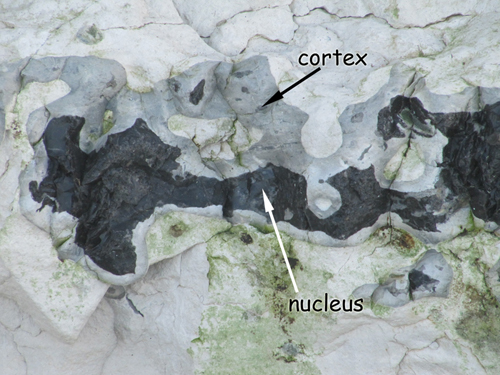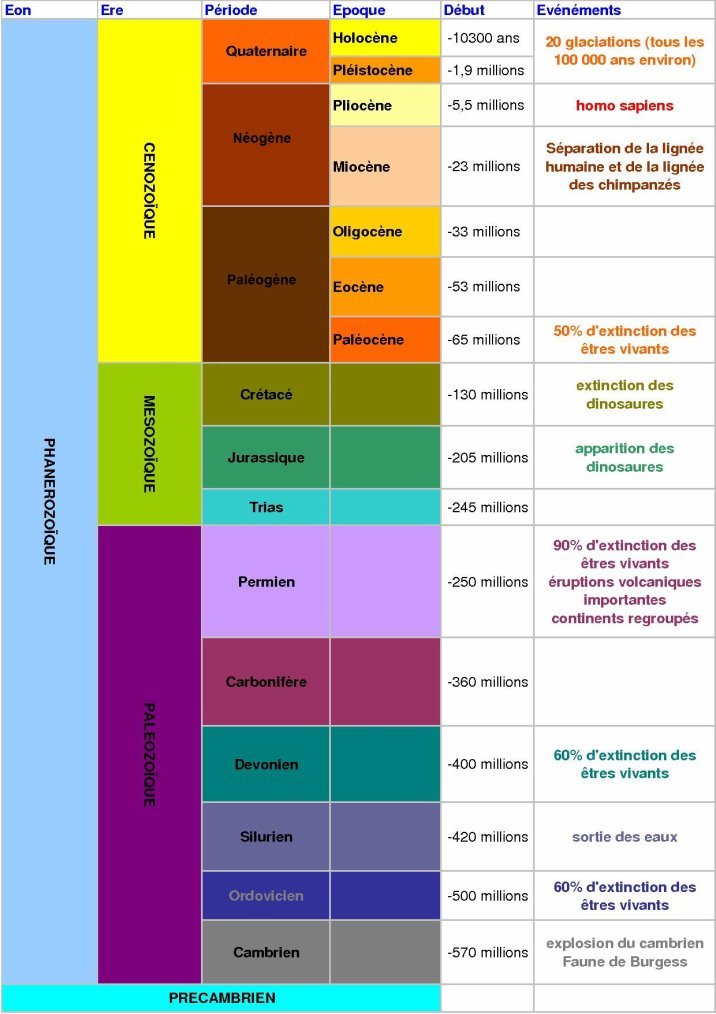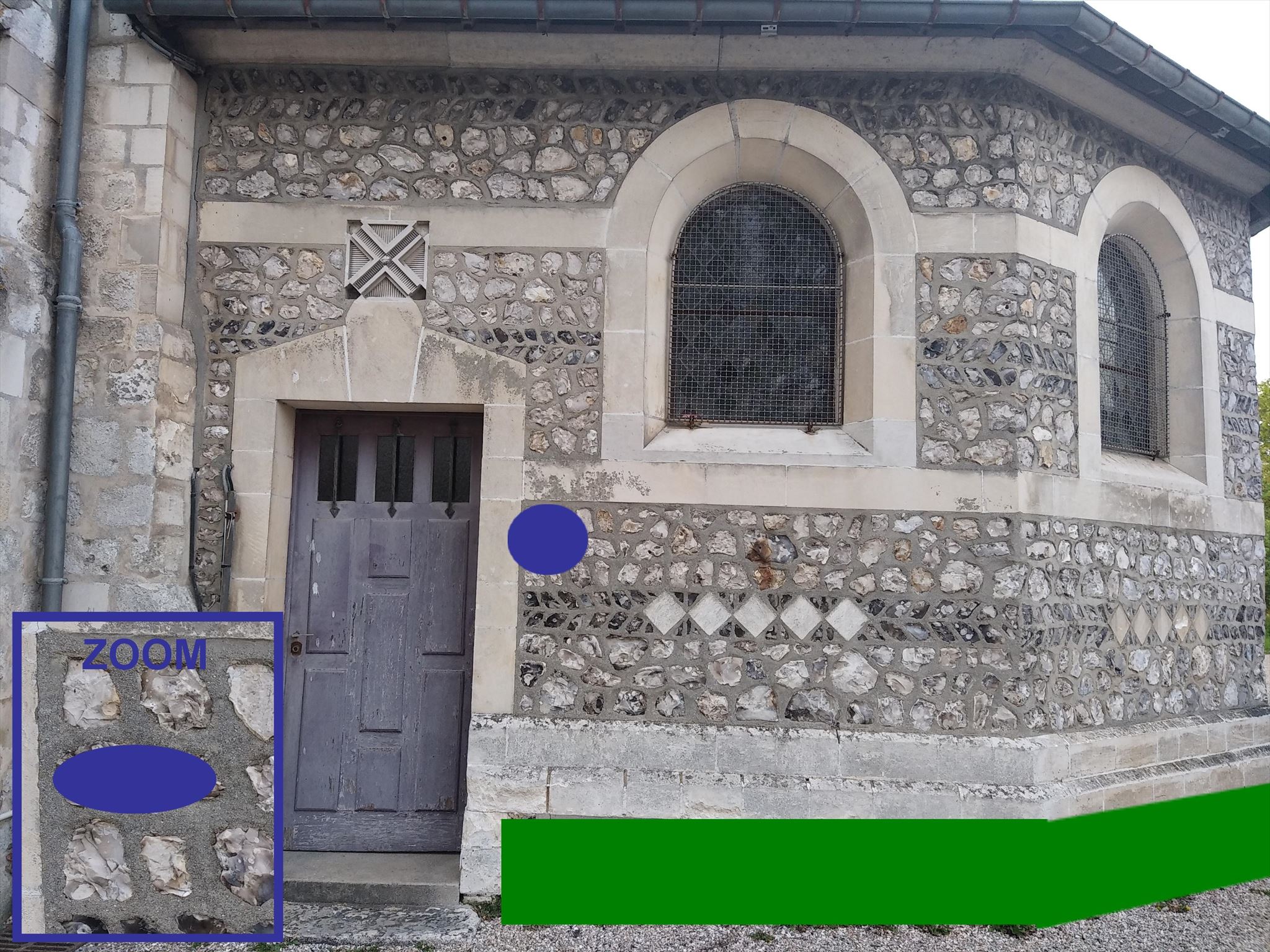VERSION FRANCAISE / ENGLISH VERSION
* * * * *

[FR]
Le silex est une roche siliceuse (SiO2) très dure. Sa cassure est lisse et conchoïdale, à éclat luisant. Les éclats de silex sont à bords aigus et translucides. La maîtrise de sa taille a permis une avancée importante pour l'évolution des hommes. On l’utilisait pendant la préhistoire pour fabriquer de nombreux outils rudimentaires comme des couteaux ou des pointes de lance.
Le silex a aussi été employé comme matériau de construction dans les pays à sous-sol crayeux dépourvus d'autres roches dures. C'est ainsi que les appareillages combinant rognons de silex et brique ont succédé au pan de bois notamment dans les constructions rurales de Haute-Normandie.
FORMATION DU SILEX :
Si le Crétacé est l'époque de la craie c'est aussi celle des silex, la roche de silice par excellence. La croûte continentale hercynienne porte une végétation luxuriante. C'est une grande partie des terres qui est alors soumise au climat chaud et humide. Des sols rouges d'altération se sont établis, au sein desquels est produite la kaolinite. Un bon drainage favorise l'altération et entraîne le silicium dissous. Les océans reçoivent d'énormes quantités de silice.
La teneur en silice des eaux marines au Crétacé supérieur était donc bien supérieure à ce qu'elle est aujourd'hui, et vraisemblablement proche de la saturation. Ces eaux étaient ainsi tout naturellement à même d'assurer la croissance cristalline de silicates, et de minéraux de silice. La cristallisation s'amorçait en une infinité de germes cristallins, juste sur le fond, dans cette étroite zone qu'est l'interface eau-sédiment. De tous petits cristaux, de taille bien inférieure au millième de millimètre, assuraient leur croissance sur les cristaux de calcite du squelette des foraminifères entre autres. Ces très fines cristallites se développaient en un empilement respectant une même orientation cristalline. Cet assemblage de fibres forme ce qu'on appelle la calcédoine.
La calcédoine a une propriété : elle se développe dans les sédiments calcaires, remplissant totalement les vides laissés entre les grains, mais sa croissance cristalline se fait aussi au détriment de la calcite qu'elle remplace point par point. Et c'est toute la masse de la boue crayeuse qui est transformée en calcédoine. La croissance est très lente et la craie continue de se déposer. L'objet s'éloigne donc de l'interface, les échanges se ralentissent puis cessent.
Les silex font donc partie du paysage crétacé. Or, cette situation climatique n'a pas duré. Après la fin du Crétacé, au début de l'ère Tertiaire le climat général du globe se refroidit et entraîne une diminution considérable des apports de silice à l'océan… Pas de silice en excès : pas de silex. Le silex est une roche fossile, qui ne se forme plus dans l'environnement actuel.
ASPECT :
Les rognons (nodules) de silex sont achevés dans une forme à tendance sphérique. Ils sont enveloppés d'une gangue plus ou moins épaisse (cortex blanc), composée d'impuretés (dépôts organiques ...) repoussées vers l'extérieur lors de la croissance. Le coeur du silex (noyau ou nucleus) est plus sombre beige, brun, gris ou noir.
Certains silex sont creux car la silicification primaire est incomplète. La circulation de l’eau dans la cavité conduit parfois à une dissolution ou une précipitation de silice secondaire sous forme de calcédoine mamelonnée aux jolis reflets bleutés ou encore de petits cristaux de quartz mimant une géode (cavité rocheuse tapissée de cristaux).
* * * * *

* * * * *
[EN]
Flint is a siliceous rock (SiO2) very hard. Its break is smooth and conchoidal, with a shiny shine. Flint flakes are sharp-edged and translucent. The mastery of its size has allowed an important advance for the evolution of men. It was used during prehistoric times to make many rudimentary tools such as knives or spearheads.
Flint has also been used as a building material in countries with chalky subsoil devoid of other hard rocks. This is how equipment combining kidneys of flint and brick took over from timber framing, particularly in rural constructions in Haute-Normandie.
FORMATION OF FLINT :
If the Cretaceous is the era of chalk, it is also that of flint, the silica rock by excellence. The Hercynian continental crust bears lush vegetation. It is a large part of the land which is then subject to the hot and humid climate. Red weathered soils are established, within which kaolinite is produced. Good drainage promotes weathering and carries away dissolved silicon. The oceans receive huge amounts of silica.
The silica content of marine waters in the Upper Cretaceous was therefore much higher than it is today, and probably close to saturation. These waters were thus quite naturally able to ensure the crystal growth of silicates and silica minerals. The crystallization began in an infinity of crystalline seeds, just on the bottom, in this narrow zone which is the water-sediment interface. Very small crystals, much less than a thousandth of a millimeter in size, ensured their growth on the calcite crystals of the skeleton of foraminifera, among others. These very fine crystallites developed in a stack respecting the same crystalline orientation. This assembly of fibers forms what is called chalcedony.
Chalcedony has a property: it develops in calcareous sediments, completely filling the voids left between the grains, but its crystalline growth is also at the expense of calcite, which it replaces point by point. And it is the whole mass of the chalky mud which is transformed into chalcedony. Growth is very slow and chalk continues to settle. The object therefore moves away from the interface, the exchanges slow down and then cease.
Flints are therefore part of the Cretaceous landscape. However, this climatic situation did not last. After the end of the Cretaceous, at the beginning of the Tertiary era, the general climate of the globe cools and leads to a considerable reduction in the supply of silica to the ocean... No excess silica : no flint. Flint is a fossil rock, which no longer forms in the current environment.
ASPECT :
The nodules of flint are finished in a spherical shape. They are enveloped in a more or less thick gangue (white cortex), made up of impurities (organic deposits, etc.) pushed outwards during growth. The heart of the flint (core or nucleus) is darker, is darker, beige, brown, grey or black.
Some flints are hollow because the primary silicification is incomplete. The circulation of water in the cavity sometimes leads to a dissolution or precipitation of secondary silica in the form of hilly chalcedony with pretty bluish reflections or even small quartz crystals mimicking a geode (rocky cavity lined with crystals).
* * * * *
Echelle stratigraphique de géologie / Stratigraphic scale of geology :
L’échelle stratigraphique de géologie est un système de classement chronologique utilisé, notamment en géologie, pour dater les événements survenus durant l’histoire de la Terre.
The stratigraphic geology scale is a chronological classification system used, particularly in geology, to date events that have occured during the history of the Earth.

Echelle de Mohs / Mohs scale :
L'échelle de Mohs fut inventée en 1812 par le minéralogiste allemand Friedrich Mohs afin de mesurer la dureté des minéraux. Elle est basée sur dix minéraux facilement disponibles. Comme c'est une échelle ordinale, on doit procéder par comparaison (capacité de l'un à rayer l'autre) avec deux autres minéraux dont on connaît déjà la dureté.
The Mohs scale was created in 1812 by the German mineralogist Friedrich Mohs, to measure minerals hardness. It is based on ten minerals easily available. As it is an ordinal scale, we proceed by comparison (capacity from one to scratch the other) with two other minerals for which we already know hardness.

* * * * *
SOURCES :
https://fr.wikipedia.org/wiki/Silex#:~:text=Le%20silex%20est%20une%20roche,derniers%20influant%20sur%20sa%20couleur.
https://fr.wikihow.com/reconnaitre-du-silex
https://craies.crihan.fr/?page_id=36
https://www.futura-sciences.com/planete/dossiers/geologie-coeur-silice-silex-wafer-567/page/3/
* * * * *
QUESTIONS :
Je vous propose d’étudier cette roche en regardant de plus près l’église de Port-Jérôme-sur-Seine.
I suggest you study this rock by looking more closely at the church of Port-Jérôme-sur-Seine.

Pour valider cette EarthCache, vous devez répondre aux questions suivantes à l'aide des éléments ci-dessus et de vos observations sur le terrain :
0) Joignez à votre log une photo de vous (ou quelque chose vous identifiant) aux coordonnées sans toutefois dévoiler les réponses.
1) Qu’est-ce qu’un silex ? Quel est son composant principal et quelles sont les 2 parties qui constituent les nodules ?
2) D’après l’échelle stratigraphique de géologie, de combien millions d’années datent la formation des silex ?
3) Prenez la pointe d’un couteau et une lame de verre et frottez-les aux silex du mur : que se passe-t-il ? Est-ce le silex qui se raye ou votre lame de verre ? Déduisez-en la dureté sur l’échelle de Mohs.
4) En vous référant à la photo, décrivez ce que vous voyez sous la zone verte ? De quelle partie du silex s’agit-il ?
5) Approchez-vous de la zone bleue de la photo et repérez l’élément du zoom : décrivez ce que pouvez-vous observer ?
Rappel concernant les Earthcaches : il n'y a pas de conteneur à rechercher ni de logbook à renseigner.
Envoyez-moi vos propositions de réponses via mon profil (nanou1) soit par mail soit via la messagerie geocaching.com (Message Center), et loguez ‘Found it’ en même temps. Je vous contacterai en cas de problème.
/!\ Les logs enregistrés sans réponses seront supprimés.
To validate this EarthCache, you must answer the following questions using the above elements and your field observations :
0) Attach to your log a picture of yourself (or something identifying you) at the coordinates without revealing the answers.
1) What is a flint ? What is its main component and what are the 2 parts that make up the nodules ?
2) According to the stratigraphic scale of geology, how many millions of years ago was the formation of the flints ?
3) Take the tip of a knife and a glass blade and rub them against the flints of the wall : what is happening ? Is it the flint that gets scratched or your glass blade ? Calculate the hardness on the Mohs scale.
4) Referring to the photo, describe what you see under the green area? What part of the flint is it ?
5) Approach the blue area of the photo and locate the zoom element: describe what can you observe ?
Reminder about Earthcaches : there is no container to serch for or logboog to fill in.
Send me your proposed answers via my profile (nanou1) either by email or via geocaching.com messaging (Message Center), and log in 'Found it' at the same time. I will contact you if there is a problem.
/!\ Logs recorded without answers will be deleted.